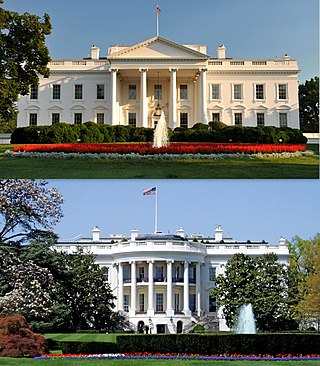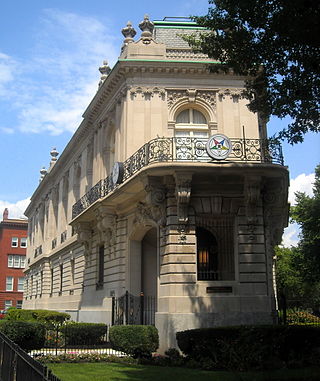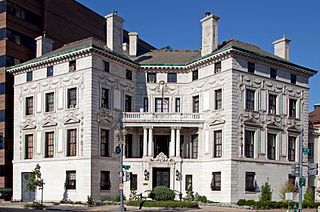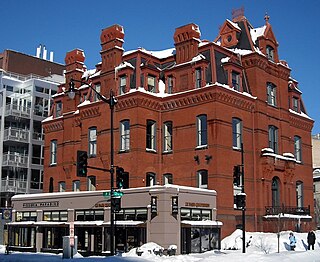
The White House is the official residence and workplace of the president of the United States. It is located at 1600 Pennsylvania Avenue NW in Washington, D.C., and has been the residence of every U.S. president since John Adams in 1800 when the national capital was moved from Philadelphia. The term "White House" is often used as metonymy for the president and his advisers.

Dupont Circle is a historic roundabout park and neighborhood of Washington, D.C., located in Northwest D.C. The Dupont Circle neighborhood is bounded approximately by 16th Street NW to the east, 22nd Street NW to the west, M Street NW to the south, and Florida Avenue NW to the north. Much of the neighborhood is listed on the National Register of Historic Places. However, the local government Advisory Neighborhood Commission and the Dupont Circle Historic District have slightly different boundaries.

Crystal Heights was a design by American architect Frank Lloyd Wright for a hotel, apartment, and shopping complex in Washington, D.C. The project would have been built on one of the largest remaining undeveloped tracts in the city, known as the Oak Lawn estate or Temple Heights, on the edge of the Adams Morgan and Dupont Circle neighborhoods. The site was bounded by 19th Street, Columbia Road, Connecticut Avenue, and Florida Avenue, all in the northwest quadrant.

The Sixteenth Street Historic District is a 1.25-mile (2.01 km) linear historic district in Washington, D.C., that includes all structures along 16th Street NW between H Street and Florida Avenue. The district's southern boundary is bordered by Lafayette Square, just north of the White House, and Meridian Hill Park on its northern boundary. It includes an eclectic mix of architectural styles on one of the city's most historic and important numbered streets including single and multi-family residential buildings, embassies, hotels, churches, and office buildings.

The Embassy of Uzbekistan in Washington, D.C.,, is the diplomatic mission of the Republic of Uzbekistan to the United States. The current Ambassador of Uzbekistan to the United States is Furqat Sidikov. The embassy is located at 1746 Massachusetts Avenue NW on Embassy Row in Washington, D.C., between Scott Circle and Dupont Circle. Constructed in 1909, the Clarence Moore House is an example of Beaux Arts architecture in blond Roman brick with limestone dressings; it was used by the Canadian government until the 1980s. The house was listed on the National Register of Historic Places (NRHP) on April 3, 1973. The building is also designated a contributing property to the Massachusetts Avenue Historic District and Dupont Circle Historic District, which are both listed on the NRHP.

The Perry Belmont House, sometimes referred to as the International Temple of the Order of the Eastern Star, though there are no ritual or ceremonial spaces in the building, is the world headquarters of the General Grand Chapter of the Order of the Eastern Star, one of several organizations affiliated with Freemasonry. The building is located at 1618 New Hampshire Avenue, Northwest in the Dupont Circle neighborhood of Washington, D.C. The International Temple was added to the National Register of Historic Places on May 8, 1973.

The L. Ron Hubbard House, also known as the Original Founding Church of Scientology, is a writer's house museum and former Scientology church located at 1812 19th Street NW in the Dupont Circle neighborhood of Washington, D.C., United States. Public tours are given on a regular basis. The operating Founding Church is now located at 1424 16th Street NW. After L. Ron Hubbard established Scientology in the 1950s the building housed offices of the Founding Church of Scientology and it is where he performed the first Scientology wedding. Hubbard's personal office was located in the building from 1956 to 1961.

The Toutorsky Mansion, also called the Brown-Toutorsky House, is a five-story, 18-room house located at 1720 16th Street, NW in the Dupont Circle neighborhood of Washington, D.C. Since 2012, it has housed the Embassy of the Republic of the Congo.

The Real World: D.C.,, is the twenty-third season of MTV's reality television series The Real World, which focuses on a group of diverse strangers living together for several months in a different city each season, as cameras follow their lives and interpersonal relationships. It is the fifth season of The Real World to be filmed in the Mid-Atlantic States region of the United States.

The Sulgrave Club is a private women's club located at 1801 Massachusetts Avenue NW on the east side of Dupont Circle in Washington, D.C. The clubhouse is the former Beaux-Arts mansion on Embassy Row built for Herbert and Martha Blow Wadsworth and designed by noted architect George Cary. During World War I the Wadsworth House was used as the local headquarters for the American Red Cross.

Château Élysée is a 1920s replica of a 17th-century French-Normandy chateau in Hollywood, California. Owned by the Church of Scientology, it is the home of Celebrity Centre International and the Manor Hotel. It is located at 5930 Franklin Avenue in the Franklin Village section of Los Angeles, California.

The former Union and New Haven Trust Building, located at 205 Church Street in New Haven, Connecticut, was the tallest building in New Haven when it was constructed in 1927. This Georgian-Colonial Revival skyscraper was designed by architects Cross and Cross. The building, sited on the northeast corner of the historic New Haven Green, changed hands several times over the years. In 2014 it was converted into residences and renamed The Union.
The Mansion on O Street is an American luxury boutique hotel in the Dupont Circle historic district of Washington D.C. The hotel is noted for eccentric interior styling which includes hidden doors, secret passages, and rooms in which all furnishings and fixtures are for sale. The four-story building contains guest rooms, a private Social club, the O Street Museum Foundation and a conference center.

The Patterson Mansion is a historic Neoclassical-style mansion located at 15 Dupont Circle NW in Washington, D.C., in the United States.

The James G. Blaine Mansion, commonly known as the Blaine Mansion, is a historic house located at 2000 Massachusetts Avenue NW, in the Dupont Circle neighborhood of Washington, D.C. The imposing house was completed in 1882 for James G. Blaine, a Republican politician from Maine who served as Speaker of the House, and later as a US Senator and US Secretary of State. He was also a presidential candidate who was narrowly defeated by Grover Cleveland in the 1884 United States presidential election.

The Leiter House was a mansion that once stood at 1500 New Hampshire Avenue NW in the Dupont Circle neighborhood of Washington, D.C. Completed in 1893 for wealthy businessman Levi Leiter, the palatial 55-room neoclassical residence was designed by architect Theophilus P. Chandler Jr., whose notable works include Trinity Episcopal Church, the Stirling mansion, St. Thomas Episcopal Church, and the North Philadelphia station. The house was one of several mansions that were built in the late 19th and early 20th centuries around the perimeter of Dupont Circle, a traffic circle and park that was considered a fashionable area at the time.

Appleton Prentiss Clark Jr. was an American architect from Washington, D.C. During his 60-year career, Clark was responsible for designing hundreds of buildings in the Washington area, including homes, hotels, churches, apartments and commercial properties. He is considered one of the city's most prominent and influential architects from the late 19th and early 20th centuries. Many of his designs are now listed on the National Register of Historic Places (NRHP).

Stewart's Castle, also referred to as Castle Stewart or Stewart's Folly, was a mansion in Washington, D.C., located on the north side of Dupont Circle between Connecticut Avenue and Massachusetts Avenue. The house owed its various names to the original owner, Senator William Morris Stewart, the imposing, turreted facade, and its prominence in an area considered undesirable at the time of its construction. Designed by architect Adolf Cluss, the house was completed in 1873 but only stood for 28 years. It was badly damaged in a fire in 1879 but later repaired and rented to the Chinese Legation from 1886 to 1893. The house was sold to Senator William A. Clark, who razed it in 1901, intending to build a new residence. The plans never came to fruition. The site remained vacant for over 20 years until the construction of a commercial building, which still stands.

The Codman Carriage House and Stable is a historic building located at 1415 22nd Street NW in the Dupont Circle neighborhood of Washington, D.C. The industrial building was constructed in 1907 as a carriage house and stable for socialite and art collector Martha Catherine Codman, who lived a few blocks north in her home, later known as the Codman–Davis House. She commissioned her cousin, Ogden Codman Jr., an architect and prominent interior decorator who also designed her home. He designed it in a Second Empire style.























